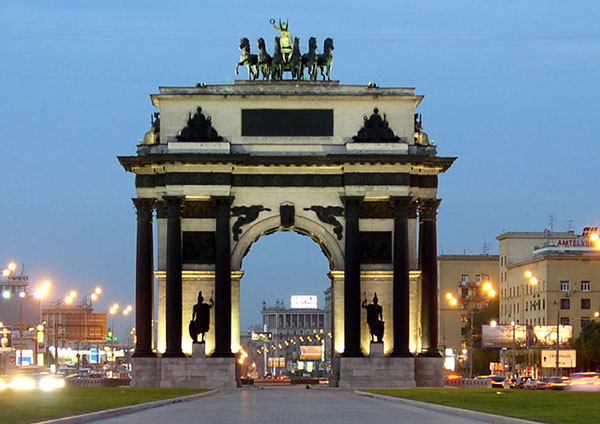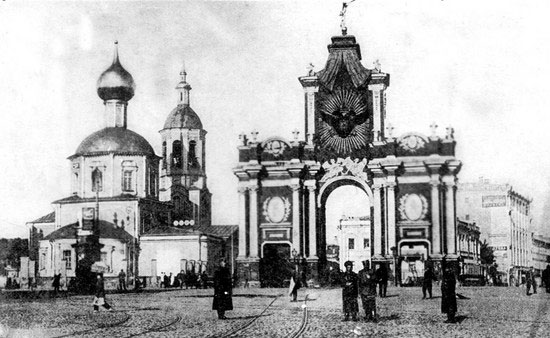
From the Arch of Triumph to the Red Gate
/ Главная / Russkiy Mir Foundation / Publications / From the Arch of Triumph to the Red GateFrom the Arch of Triumph to the Red Gate

On May 30 the six iron horses driven by Nike was returned to its former place after a speedy restoration. The Arch of Triumph on Kutuzovsky Avenue in Moscow regained its original look. On September 8, when the Battle of Borodino is commemorated, the memorial complex will be officially opened.
A joyful event?
You bet! Especially given that the Arch of Triumph saw many days of trouble. In 1814 Emperor Alexander I ordered the erection of a wooden arch in Moscow's Triumph Square in anticipation of the return of the triumphant soldiers. They were in a hurry and had no time to set up a permanent structure or to restore half of Moscow's houses that burned down in 1812.
The next emperor Nicholas ordered that the decrepit wooden Arch of Triumph be taken down and new monumental stone one erected in its place at the entrance to Moscow at Tver Gates. The work led by chief city architect and participant of the Patriotic War Osip Bove lasted five years. The arch was inaugurated in 1834. Bove himself did not live long enough to see this hour of triumph, however.
One hundred years later the reconstruction of the square at the Belarus Train Station (former Tver Station) commenced. Pragmatism prevailed and the Arch was dismantled for the sake of a new transport concept. Only in 1962, in connection with the 150th anniversary of the Patriotic war, the Arch was remembered and reassembled by 1968 – this time in its former place on Poklonnaya Hill, which was flattened back in the 1850s. Probably it stood in the way of the traffic flows. Today the monument's future causes no concern. The Arch is here and will be here in the days to come. The only perturbing thing is the statement recently made by Head of Moscow Cultural Heritage Department Mr Kibovsky who said that the harness, chariot and Nike herself after restoration would definitely last 10-15 years. Who knows, maybe the city authorities will have enough enthusiasm and money to make a decision about the next restoration? We'll wait and see.
In short, this is good news, generally speaking, but there is another one which is actually a well-forgotten story.
There was once upon a time another arch of triumph in Moscow, devoted to another great victory at Poltava. In 1709 Peter the Great wished that the memorial gate be set up on the way from Krasnoe village to the original capital city. Through them the vanquishing soldiers were to return to the city. This is exactly what happened a century later in 1814.

The site was chosen at Prolomnye Gate of the Earthen city that led from Basmanny district to Myasnitskaya Street. This time a wooden gate was made. In the late 1730s it burnt down, which was quite typical in Moscow in those days. The arch was restored in 1743 in honor of Empress Elizaveta's coronation. Made of wood, it soon burnt to ashes again.
In the 1750s the project was tackled by Moscow-based architect Prince Dmitry Ukhtomsky. He used old drawings and sketches but applied different materials. The arch became 26 meters taller and overgrew with stucco molding, bronze sculptures and, despite its white color, was christened by people as the Red or Beautiful Gates (Krasnye Vorota) for their stunning beauty. In reality, unlike most arches of triumph built in Moscow, St. Petersburg, Paris, Berlin that reproduced the ancient Roman tradition to some extent, Red Gates are a marvelous sample of Russian baroque.
During the coronation of Catherine the Great the square at the Red Gates became the center of a folk festival that lasted three days. Later on this turned into one of the city's traditions, with mask shows, processions and pre-Lent week games arranged here regularly...
Years went by. At the beginning of the 20th century a tram line slipped through the Red Gates as a link between Chistoprudny Blvd. and Sokolniki. This seemed fine, but the city authorities concerned over the transport problem like in our days, thought something had to be done with the arch. And what could the restless Soviet officials think about, except to demolish it, given they had already gained some experience in this area? In December 1926 Moscow Soviet (chaired by comrade Ukhanov) approved its demolition! Even though in spring of the same year the Red Gates had just undergone major repairs whereby the time-worn architectural-artistic superfluities were restored! This plan was opposed by many: from academics to common people, from education commissar Lunacharsky to... transport officials. Yes, those whose opinion was cited as justification of the moral crime openly argued that the arch demolition would not improve the transport situation. But the authorities probably had other reasons. The Presidium of the Executive Committee (chaired by comrade Kalinin) ratified the resolution of the Moscow Soviet.
On June 3, 1927, 85 years ago, the Red Gates were destroyed. It took two full months to raze completely them, since this monument of Elizaveta's baroque was very solidly built. The gilt statue of the trumpeting angel is still part of the State Historical Museum's exposition.
I am telling you this to make the following point. When the festival commemorating the Patriotic war of 1812 is over, another remarkable jubilee awaits the country of Russia in 2021: the 300th anniversary of victory in the Northern War that transformed the peripheral Muscovy into the Russian Empire. And the Red Gates is the memorial devoted to victory in that long and important war waged by Peter the Great against Swedes.
No Russian person can overlook another notable date: 200th birthday of great Russian poet Mikhail Lermontov, who happened to be born in the house sitting right opposite the Red Gates and to be baptized in the Church of Three Holy Hierarchs built in that square as early as in the XVII century, beside the Red Gates!
This church was also pulled down by Soviets in 1928 and it's hardly possible to restore it in rather cramped space at the Red Gates. But what about the Gates? What if they fit in?
Mikhail Bykov
| Tweet |
New publications

 Mikhail Kalatozov, a director who transformed the world of cinematography in many ways, was born 120 years ago. He was a Soviet film official and a propagandist. Above all, he was capable of producing movies that struck viewers with their power and poetic language.
Mikhail Kalatozov, a director who transformed the world of cinematography in many ways, was born 120 years ago. He was a Soviet film official and a propagandist. Above all, he was capable of producing movies that struck viewers with their power and poetic language.  Ukrainian authorities have launched a persecution campaign against the canonical Ukrainian Orthodox Church (UOC), the biggest one in the country's modern history. Over the past year, state sanctions were imposed on clergy representatives, searches were conducted in churches, clergymen were arrested, criminal cases were initiated, the activity of the UOC was banned in various regions of the country, and monasteries and churches were seized.
Ukrainian authorities have launched a persecution campaign against the canonical Ukrainian Orthodox Church (UOC), the biggest one in the country's modern history. Over the past year, state sanctions were imposed on clergy representatives, searches were conducted in churches, clergymen were arrested, criminal cases were initiated, the activity of the UOC was banned in various regions of the country, and monasteries and churches were seized.  When Nektary Kotlyaroff, a fourth-generation Russian Australian and founder of the Russian Orthodox Choir in Sydney, first visited Russia, the first person he spoke to was a cab driver at the airport. Having heard that Nektariy's ancestors left Russia more than 100 years ago, the driver was astonished, "How come you haven't forgotten the Russian language?" Nektary Kotlyaroff repeated his answer in an interview with the Russkiy Mir. His affinity to the Orthodox Church (many of his ancestors and relatives were priests) and the traditions of a large Russian family brought from Russia helped him to preserve the Russian language.
When Nektary Kotlyaroff, a fourth-generation Russian Australian and founder of the Russian Orthodox Choir in Sydney, first visited Russia, the first person he spoke to was a cab driver at the airport. Having heard that Nektariy's ancestors left Russia more than 100 years ago, the driver was astonished, "How come you haven't forgotten the Russian language?" Nektary Kotlyaroff repeated his answer in an interview with the Russkiy Mir. His affinity to the Orthodox Church (many of his ancestors and relatives were priests) and the traditions of a large Russian family brought from Russia helped him to preserve the Russian language.

 The leaders of the Friends of the Great Russia cultural association (Amici Della Grande Russia) in Italy believe that the Western policy of abolishing Russian culture in Europe has finally failed. Furthermore, it was doomed to failure from the beginning.
The leaders of the Friends of the Great Russia cultural association (Amici Della Grande Russia) in Italy believe that the Western policy of abolishing Russian culture in Europe has finally failed. Furthermore, it was doomed to failure from the beginning.  Name of Vladimir Nemirovich-Danchenko is inscribed in the history of Russian theater along with Konstantin Stanislavski, the other founding father of the Moscow Art Theater. Nevertheless, Mr. Nemirovich-Danchenko was a renowned writer, playwright, and theater teacher even before their famous meeting in the Slavic Bazaar restaurant. Furthermore, it was Mr. Nemirovich-Danchenko who came up with the idea of establishing a new "people's" theater believing that the theater could become a "department of public education."
Name of Vladimir Nemirovich-Danchenko is inscribed in the history of Russian theater along with Konstantin Stanislavski, the other founding father of the Moscow Art Theater. Nevertheless, Mr. Nemirovich-Danchenko was a renowned writer, playwright, and theater teacher even before their famous meeting in the Slavic Bazaar restaurant. Furthermore, it was Mr. Nemirovich-Danchenko who came up with the idea of establishing a new "people's" theater believing that the theater could become a "department of public education."  "Russia is a thing of which the intellect cannot conceive..." by Fyodor Tyutchev are famous among Russians at least. December marks the 220th anniversary of the poet's birth. Yet, he never considered poetry to be his life's mission and was preoccupied with matters of a global scale. Mr.Tyutchev fought his war focusing on relations between Russia and the West, the origins of mutual misunderstanding, and the origins of Russophobia. When you read his works today, it feels as though he saw things coming in a crystal ball...
"Russia is a thing of which the intellect cannot conceive..." by Fyodor Tyutchev are famous among Russians at least. December marks the 220th anniversary of the poet's birth. Yet, he never considered poetry to be his life's mission and was preoccupied with matters of a global scale. Mr.Tyutchev fought his war focusing on relations between Russia and the West, the origins of mutual misunderstanding, and the origins of Russophobia. When you read his works today, it feels as though he saw things coming in a crystal ball...